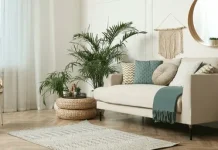You may still show off your style even if your house isn’t too big. Just like decorating a vast area, designing a tiny one demands creative thinking and a keen sense of what works and doesn’t. And while the focus will inevitably change a little bit when dealing with less space, the fundamental principles of design remain unchanged.
We guarantee that working in a small place isn’t difficult. Follow the advice below for small apartment planning and making your home shine, whether you’re trying to figure out how to add a personal touch to your new studio apartment or need some advice on how to make the most of space in a not-so-spacious house.
- Think about color
Avoid dark colors, especially in your paint, if you want to make the most of your area. Dark colors reduce reflection and absorb light, giving the impression that the space is smaller. Walls should be painted in hues of yellow, white, and grey. Depending on your flooring, you might want to keep with white-colored furnishings so that decorating will be more straightforward in the future. White frequently gives spaces a fresh, airy impression.
It would help if you also thought about the colors of your furnishings, décor, and other items in the space. It would help to concentrate on neutral hues to make a space feel less cluttered. Use neutral tones and keep everything straightforward and open. Utilize your furniture or decorations like books, cushions, and plants if you think the room may need a splash of color.
- Mirror, Mirror
Professional interior designers often use mirrors because they optically enlarge tiny spaces and provide the impression of a much larger area. Optical illusions are crucial in dark, cramped settings and excel in locations with abundant natural light. Mirrors work best when positioned in the room’s darkest corners, behind pieces of furniture, and in front of windows. Your choice of mirrors should be minimal.
- Discreet Decor
Small rooms are an excellent opportunity for optical illusions, and the right décor may fool the eye even if you created the space yourself. The space might appear more significant thanks to the long drapes. Floor-to-ceiling designs give any area the appearance of lengthening when you use them. Translucent curtains are brilliant since they give your space a more open, breezy feel. Buy solid and transparent layers of curtains instead of dark ones if you need them to hide the light. Then, hang them together.
Use plants to decorate. Plants add vitality and a sense of natural tranquility to their environment. Think of indoor plants like pothos, bonsai, bamboo palms, and spider plants. Consider low-light plants if your space doesn’t get much natural light. The smaller area could always be filled with flower arrangements, which you could switch up whenever you want a fresh vibe or burst of color.
- Feelin’ Furniture
Your room’s furniture should enhance the space. Aim for simple furniture like loveseats and armchairs. If you take the time to analyze your area, you can pack some furnishings that will fit snugly and perfectly.
Consider some practical and light furniture to maintain the breezy atmosphere of your tiny area. The bamboo frames are excellent and won’t dominate the space. Several design options might incorporate various pillows and cushions in the season’s hue. If you want to save room, try for little end tables or footstools that can fold up or be hidden. You might not need a table if you can use furniture with a different surface or table space.
- Optimize the Wall Space
Even though we should know better, so many of us fail to make the most of the most significant aspect of space in our homes: the walls. This is an important interior design tip if you’re looking for some. Shelves are your buddies, so your storage space doesn’t have to be limited to the area around your feet! Books, plants, decorations, picture frames, and more may be stored on shelves! You may even put shelves at chair level for an additional table or cup space.
- Light It Up
When lighting your little room, make use of the walls. You may hang string lights and wall sconces instead of using valuable table space with lamps. Remember that any lighting you add will work with your mirrors and optimize the sensation of the space when hanging lights at different heights across the room.
- Don’t Forget the Floor
There are many methods to change the flooring in your little area, even if you may not have much control over it. Count on rugs that complement the look and feel of your room. If you want a room to feel light, airy, and expansive, think about installing bamboo flooring since it could increase the optical illusion by drawing attention to the floor. Large carpets may give a room the illusion of space. A diversity of carpets may make a room feel bigger, especially if they have its primary colors.
- Divide and conquer
Using translucent curtains, room dividers made of rice paper, or open shelves, you may split up your small area without making it seem too crowded. For your area to seem as spacious and open as possible, it’s essential that light can still pass through all of these alternatives. These kinds of partitions also function as striking design features in and of themselves, giving your house more panache.
- Organize your kitchen.
The kitchen should be the most adaptable space in the home, providing a welcome space where cooks may prepare meals, snacks, and entertaining materials. Use drawer organizers for dry goods and food storage containers, vertical storage shelves in your pantry, or hooks to hang mugs and bowls to organize your kitchen. To make room underneath your countertops, throw out stale food and partially consumed dry products and add overhead pot and pan storage.
Clearing the clutter create more space
Eliminating clutter is a simple approach to making the most of the space in your house. Check out our crazily comprehensive decluttering guide to help you organize your home room by room because it’s not always simple to decide where to start.








